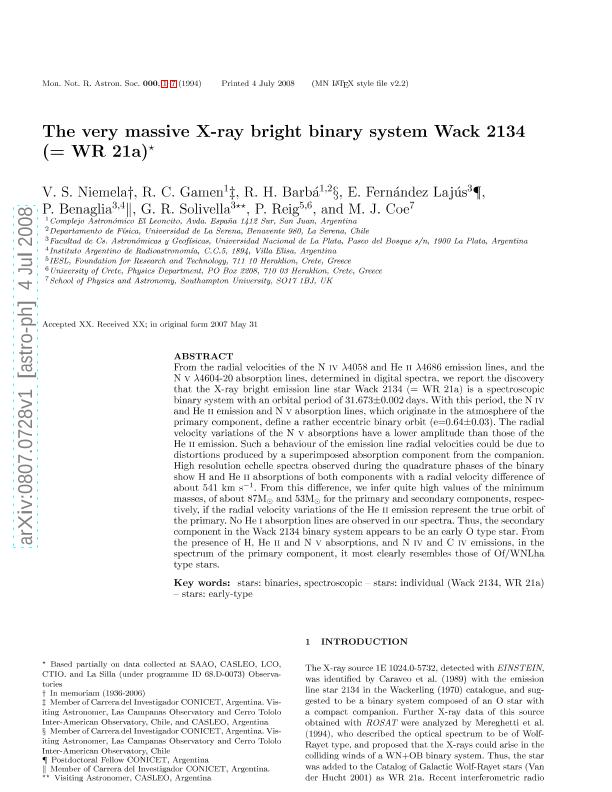Mostrar el registro sencillo del ítem
dc.contributor.author
Niemela, Virpi Sinikka

dc.contributor.author
Gamen, Roberto Claudio

dc.contributor.author
Barba, Rodolfo Hector

dc.contributor.author
Fernandez Lajus, Eduardo Eusebio

dc.contributor.author
Benaglia, Paula

dc.contributor.author
Solivella, Gladys Rebeca

dc.contributor.author
Reig, P.
dc.contributor.author
Coe, M. J.
dc.date.available
2017-11-08T14:21:32Z
dc.date.issued
2008-09
dc.identifier.citation
Niemela, Virpi Sinikka; Gamen, Roberto Claudio; Barba, Rodolfo Hector; Fernandez Lajus, Eduardo Eusebio; Benaglia, Paula; et al.; The very massive X-ray bright binary system Wack 2134 (= WR 21a)
; Oxford University Press; Monthly Notices of the Royal Astronomical Society; 389; 3; 9-2008; 1447-1452
dc.identifier.issn
0035-8711
dc.identifier.uri
http://hdl.handle.net/11336/27807
dc.description.abstract
From the radial velocities of the NIV λ4058 and HeII λ4686 emission lines, and the NV λ4604-20 absorption lines, determined in digital spectra, we report the discovery that the X-ray bright emission line star Wack2134 (= WR21a) is a spectroscopic binary system with an orbital period of 31.673 +/- 0.002d. With this period, the NIV and HeII emission and NV absorption lines, which originate in the atmosphere of the primary component, define a rather eccentric binary orbit (e = 0.64 +/- 0.03). The radial velocity variations of the NV absorptions have a lower amplitude than those of the HeII emission. Such a behaviour of the emission line radial velocities could be due to distortions produced by a superimposed absorption component from the companion. High-resolution echelle spectra observed during the quadrature phases of the binary show H and HeII absorptions of both components with a radial velocity difference of about 541kms-1. From this difference, we infer quite high values of the minimum masses, of about 87 and 53Msolar for the primary and secondary components, respectively, if the radial velocity variations of the HeII emission represent the true orbit of the primary. No HeI absorption lines are observed in our spectra. Thus, the secondary component in the Wack2134 binary system appears to be an early O-type star. From the presence of H, HeII and NV absorptions, and NIV and CIV emissions, in the spectrum of the primary component, it most clearly resembles those of Of/WNLha-type stars. Based partially on data collected at SAAO, CASLEO, LCO, CTIO and La Silla (under programme ID 68.D-0073) Observatories.
dc.format
application/pdf
dc.language.iso
eng
dc.publisher
Oxford University Press

dc.rights
info:eu-repo/semantics/openAccess
dc.rights.uri
https://creativecommons.org/licenses/by-nc-sa/2.5/ar/
dc.subject.classification
Astronomía

dc.subject.classification
Ciencias Físicas

dc.subject.classification
CIENCIAS NATURALES Y EXACTAS

dc.title
The very massive X-ray bright binary system Wack 2134 (= WR 21a)
dc.type
info:eu-repo/semantics/article
dc.type
info:ar-repo/semantics/artículo
dc.type
info:eu-repo/semantics/publishedVersion
dc.date.updated
2017-10-12T19:39:20Z
dc.journal.volume
389
dc.journal.number
3
dc.journal.pagination
1447-1452
dc.journal.pais
Reino Unido

dc.journal.ciudad
Oxford
dc.description.fil
Fil: Niemela, Virpi Sinikka. Universidad Nacional de la Plata. Facultad de Ciencias Astronómicas y Geofísicas; Argentina
dc.description.fil
Fil: Gamen, Roberto Claudio. Consejo Nacional de Investigaciones Científicas y Técnicas. Centro Científico Tecnológico Conicet - La Plata. Instituto de Astrofísica La Plata. Universidad Nacional de La Plata. Facultad de Ciencias Astronómicas y Geofísicas. Instituto de Astrofísica la Plata; Argentina
dc.description.fil
Fil: Barba, Rodolfo Hector. Consejo Nacional de Investigaciones Científicas y Técnicas. Centro Científico Tecnológico Conicet - San Juan. Complejo Astronómico "El Leoncito". Universidad Nacional de Córdoba. Complejo Astronómico "El Leoncito". Universidad Nacional de la Plata. Complejo Astronómico "El Leoncito". Universidad Nacional de San Juan. Complejo Astronómico "El Leoncito"; Argentina
dc.description.fil
Fil: Fernandez Lajus, Eduardo Eusebio. Universidad Nacional de la Plata. Facultad de Ciencias Astronómicas y Geofísicas; Argentina. Consejo Nacional de Investigaciones Científicas y Técnicas; Argentina
dc.description.fil
Fil: Benaglia, Paula. Provincia de Buenos Aires. Gobernación. Comisión de Investigaciones Científicas. Instituto Argentino de Radioastronomía. Consejo Nacional de Investigaciones Científicas y Técnicas. Centro Científico Tecnológico Conicet - La Plata. Instituto Argentino de Radioastronomía; Argentina
dc.description.fil
Fil: Solivella, Gladys Rebeca. Universidad Nacional de la Plata. Facultad de Ciencias Astronómicas y Geofísicas; Argentina. Consejo Nacional de Investigaciones Científicas y Técnicas; Argentina
dc.description.fil
Fil: Reig, P.. Foundation for Research and Technology; Grecia
dc.description.fil
Fil: Coe, M. J.. Southampton University; Reino Unido
dc.journal.title
Monthly Notices of the Royal Astronomical Society

dc.relation.alternativeid
info:eu-repo/semantics/altIdentifier/doi/http://dx.doi.org/10.1111/j.1365-2966.2008.13684.x
dc.relation.alternativeid
info:eu-repo/semantics/altIdentifier/url/https://academic.oup.com/mnras/article-lookup/doi/10.1111/j.1365-2966.2008.13684.x
Archivos asociados
